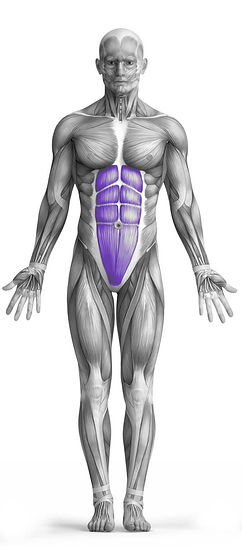Stomach Vacuum 101 Video Tutorial
0

Exercise Synopsis
Target Muscle Group
Abs
Secondary Targets
Execution
Isolation
Force Type
Isometric
Required Equipment
Bodyweight
Fitness Level
Beginner
Variations
None
Alternatives
Timer
Hour
Minute
Second
Stopwatch
00:00:00:00
Overview
The Stomach Vacuum exercise is a unique and effective method for targeting the abdominal muscles, with a primary focus on the transverse abdominis, while also engaging the rectus abdominis. This exercise involves the conscious contraction and drawing-in of the abdominal wall, creating a vacuum-like effect. While its primary aim is to strengthen and tone the abs, the Stomach Vacuum also benefits the lower back muscles by promoting core stability and improving posture. Remarkably, no equipment is necessary for this exercise, as it solely relies on body weight and the mind-muscle connection. By consistently incorporating the Stomach Vacuum into a workout routine, individuals can develop stronger, more defined abs and a stable core, enhancing overall abdominal strength and function.
How to Perform
Begin by lying on your back with your spine in a neutral position, knees bent, and feet flat on the floor.
Optionally, for better awareness of the contraction, place two fingers on the top of your hip bones and move them inward and downward by about an inch (2.54 cm), targeting the area where the transversus abdominis contracts.
Inhale deeply through your nose, then exhale slowly through pursed lips, as if releasing air from a tire. Simultaneously, engage your lower abdominal muscles by drawing them inward. Visualize your belly button being pulled towards your spine to enhance the contraction.
Maintain normal breathing patterns while holding the contraction in your abs. Avoid holding your breath, as this indicates improper muscle engagement. Aim to sustain the contraction for at least 20 to 30 seconds.
Repeat the exercise for 2 to 3 sets, focusing on the quality of the contraction and maintaining proper form throughout. No equipment is required for this bodyweight exercise, which not only targets the abs but also engages the lower back muscles to promote core stability and posture.
★ Bonus: For exercises that involve external weights (such as dumbbells, barbells, or machines), the One Rep Max (1RM) calculator can help you estimate your maximum lifting capacity. Use it to track your strength progress and adjust your training for optimal results.
Tips
Avoid the urge to hastily "suck in" your stomach. The Stomach Vacuum exercise requires a gradual contraction of the transversus abdominis, not a quick inhale. This deliberate inward drawing of the abdominal muscles should be synchronized with your breathing pattern for optimal effectiveness.
Maintain proper posture throughout the exercise. Refrain from hunching over or tilting your pelvis forward, as this can shift the focus away from the transversus abdominis and engage the rectus abdominis instead.
Ensure that you continue to breathe naturally while performing the Stomach Vacuum. Proper contraction of the transversus abdominis allows for unrestricted breathing, so if you find yourself struggling for air, reassess your technique.
Utilize tactile feedback by placing your hands or fingertips on your lower abs, approximately an inch inward and downward from your hip bones. This can help you gauge the effectiveness of your transversus abdominis contraction.
Acknowledge the involvement of other muscles, particularly the pelvic floor muscles, during the Stomach Vacuum. By focusing on drawing the stomach in, you can also strengthen these muscles, contributing to overall core stability and function.
How Not to Perform
Avoid holding your breath or creating excessive tension in the neck and shoulders; instead, maintain relaxed breathing and focus on engaging the abdominal muscles.
Refrain from arching your back or tilting your pelvis excessively during the exercise, as this can shift the focus away from the abs and increase the risk of lower back strain.
Do not rush through the movement or perform it hastily; instead, focus on slow and controlled contractions of the transversus abdominis for maximum effectiveness.
Avoid overarching or hollowing the lower back; maintain a neutral spine position throughout the exercise to minimize stress on the lumbar spine and maximize abdominal engagement.
Do not rely solely on tactile cues; while placing hands on the lower abs can provide feedback, ensure that you are also mentally engaging the target muscle group for a more effective workout.
Avoid excessive tension in the pelvic floor muscles; while they may be engaged to some extent, the primary focus should remain on the contraction of the transversus abdominis.
Refrain from allowing the chest to collapse or the shoulders to round forward; maintain an open chest and upright posture to ensure proper alignment and muscle activation.
Do not hold the contraction for too long without adequate rest; aim for shorter intervals of contraction followed by relaxation to prevent muscle fatigue and optimize performance.
Avoid distractions or multitasking during the exercise; focus your attention and energy on executing each repetition with precision and intentionality.
Do not neglect proper warm-up and cooldown routines; preparing the body adequately before performing the Stomach Vacuum and allowing for proper recovery afterward can help prevent injuries and enhance results.
Variations
Variations of fitness exercises refer to different ways of performing a specific exercise or movement to target various muscle groups, intensities, or goals. These variations aim to challenge the body differently, prevent plateaus, and cater to individuals with varying fitness levels.
Alternatives
Alternative exercises in fitness refer to different movements or activities that target similar muscle groups or serve the same training purpose as the primary exercise. These alternative exercises can be used as substitutes when the original exercise is unavailable or challenging to perform due to various reasons such as equipment limitations, injuries, or personal preferences.








